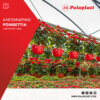
BEETROOT: Cultivation Characteristics and Irrigation
- Beetroot, scientific name Beta vulgaris of the Amaranth family (Chenopodiaceae), is an important crop, cultivated both for its root and leaves. Beetroot is a biennial plant, but it is usually grown as an annual for the harvest of its root and leaves, while in the second year it flowers and produces seeds.
- For beetroot cultivation, we can either plant seeds or obtain ready-made plants from a nursery. Planting is done in the fall or early spring. Most beetroot varieties thrive in cool environments, with ideal temperatures ranging from 15°C to 25°C. In conditions of frost or extreme heat, beetroot roots do not develop properly, resulting in reduced yield.
- The soil requirements for beetroot cultivation include well-drained, deep, and organic-rich soils, with a pH of 6.0 – 7.5. Clay and sandy soils are also suitable, as long as drainage is ensured, since stagnant water can cause root rot.
- Nutritionally, beetroot is rich in vitamins, minerals, and antioxidants while being low in calories. Among its beneficial properties is the improvement of cardiovascular health, as regular consumption can help reduce the risk of heart diseases. Beetroots have strong antioxidant activity due to the betalains they contain, which help combat free radicals, reducing the risk of inflammation and chronic diseases like cancer. Additionally, beetroots boost the immune system as they are a good source of vitamin C.
BEETROOT IRRIGATION
What are the water requirements for beetroot?
Irrigation is crucial for the proper development of beetroot, as it directly affects the quality and size of the root. Key elements for beetroot irrigation include:
- Irrigation frequency: Beetroot requires regular watering, especially during dry periods or when temperatures are high. The soil should be kept consistently moist, but not overly saturated, to avoid root rot. Irrigation should be done every 7-10 days, depending on climatic conditions and soil type, while in the early stages of growth, watering may be more frequent.
- Amount of water: The amount of water needed depends on the season and soil type. On average, 25-40 mm of water is required per week. In sandy soils, which drain more easily, irrigation should be more frequent, whereas in clay soils that retain moisture, watering can be less frequent.
- Critical stages for irrigation: Watering is especially critical during the vegetative growth stage and root swelling. Lack of water during these phases can reduce yield and degrade root quality.
What are the most common irrigation methods for beetroot?
- Drip irrigation allows water to be supplied exactly where it is needed without overwatering the surrounding soil, reducing weed growth as well.
- Sprinkler irrigation can be used, but it may cause problems if the leaves get too wet or if it compacts the soil.
- Furrow irrigation: This traditional method is mainly used in large areas but requires caution to avoid overwatering and to ensure proper drainage.
What is the most recommended irrigation system for beetroot cultivation?
Drip irrigation is considered the most efficient method for beetroot cultivation, providing better water management and reducing the risk of weed growth and diseases.
Palaplast has a wide range of products that can be used to install a reliable and efficient drip irrigation system or irrigation with micro-sprinklers system for beetroot cultivation:
- Irrigation pipes AGROPAL HDPE 80 και LDPE
- Pressure Compensating Driplines, Driplines (Paladrip – Palaplast, Paladrip-XL – Palaplast, Paladrip-Slim – Palaplast)
- Dripline fittings
- Clamp saddles
- Filters
- Micro-sprinklers


